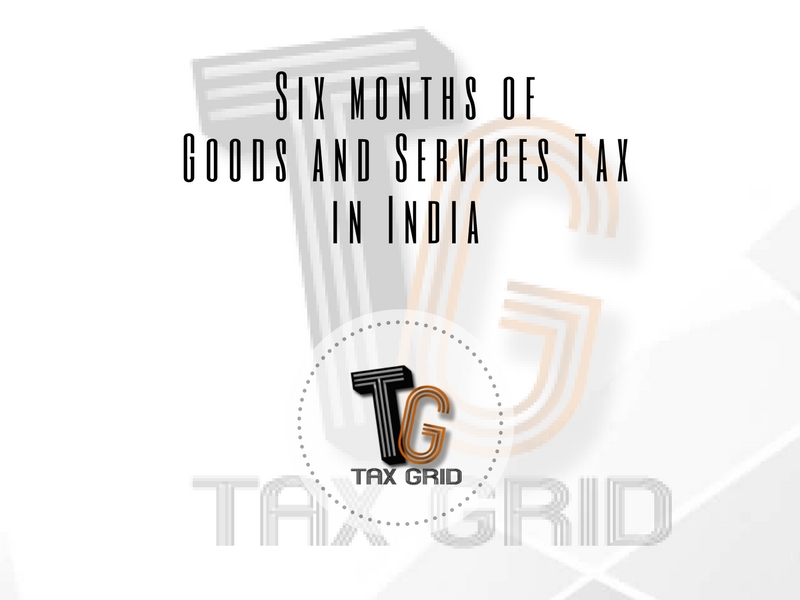Six months of Goods and Services Tax in India

Six months of Goods and Services Tax in India and Way Forward
The midnight of 1st July 2017 experienced the future changing historic tax reform in India in the form of introduction of Goods and Services Tax (GST). It was the historic midnight between 30th June and 1st July wherein both the houses convened their session at the central hall of parliament. It was one of the few special sessions which have been conducted in the midnight.
Implementing GST after getting it passed from both the houses, Lok Sabha and Rajya Sabha, was like a dream coming true at one point of time because the law was constantly being opposed by the major political parties opposing the ruling party. Due to the opposition and delays, the deadline of introducing new tax from the beginning of the financial year was missed and further the new date was decided in the middle of the year. However, overcoming all the hurdles GST was finally introduced and today we are standing at about six and a half months since it was implemented.
The new tax is now almost a half year old but still, the taxpayers are riding the roller coaster, as there are many things which are not yet stable and need to be worked upon besides the few benefits which are obviously going to help the economy grow. Many new unforeseen problems have been experienced by the stakeholders, which have been a major reason for the critics to constantly speak against the government policies. GST was not a major problem for large companies as they started preparing for the new law timely, wherein many companies restructured their business models, improving the way they take-up operations to be compliant with GST. Many billion turnover companies were required to change their IT systems to be compatible as per new law. Conversely, the new law appeared as a hindrance to small businesses.
When the GST was introduced economy was still recovering from the Demonetisation effect which was announced by the government in November 2016. When the new tax came into the force, the economy was hit hard and the news channels were full of headlines claiming adverse impact on economy in the form of labours losing their jobs, many small factories being shut down due to decrease in sales and increase in their cost, many companies faced losses and so on, although the setback was a short-term effect and now most of the business small as well as large have recovered. The government has clearly stated that its policy objective of introducing GST is to make India a preferable place to do business. Their consistent efforts have also been successful as India recently jumped 30 places to the 100th position in the World Bank’s ‘Ease of Doing Business’ index. Further, the expectations are there that once GST benefits are reaped fully into the businesses, ranking shall further improve.
GST aims at unifying taxes across the country so that the seamless flow of input tax credit can be initiated and the tax cascading is avoided. GST has been designed to bring the complete supply chain into the ambit of taxation so that the cash economy can be curbed and revenue can be increased. This is not only said but now it has even been seen that since 1st July 2017 there has been a massive increase in a number of taxpayers. Many new businesses have sought registrations under GST who were not registered for any of the indirect taxes in the previous regime, because under GST even if one person was registered, it forced the complete supply chain to pay tax.
The main problem which the taxpayers are facing and due to which the new tax is criticized again and again is the technical problem being faced by the assessee in complying with the new tax law. In GST, it was thrived to build a new taxation system which is completely technology driven as now India has moved towards Digital India and digitization has now become the necessity as much as fashion. Goods and Services Tax Network (GSTN) was setup to accomplish the task of building the complete online mechanism of compliance. GSTN since then has been said to be the IT backbone of the tax.
Tender to provide the technical support to GSTN was awarded to Infosys for an amount of Rs 1380 crores. The aim was to create the online system which can be automated as much as possible. At GSTN, various professional consultancy firms were also hired to provide the legal support in building the system. After various months of brainstorming and mutual hard work of numerous professionals, GSTN came up with the GST common portal i.e. www.gst.gov.in .
GST online common portal has been designed to perform several functions such as the furnishing of intimation forms, claiming refund etc. but the major and core function being the filing of “Returns” and payment of taxes. There were discussions and expectations that economy might face severe problems in GST regime but it was less thought and evaluated that the uncertainties would be caused by the same technology which was assigned the task to be the backbone of newborn tax.
Complication being faced by taxpayers under GST needs no discussion. Such complications have arisen due to the mix of many reasons like public finding it difficult to adapt to new taxation system and also there is somewhere lack of government in properly building the technology infrastructure for the new system. Taxpayers have waited for hours to file their return correctly as the system went down various times. Then came the new issues of wrong filing of returns wherein public was aggressive as they were not able to initially edit the incorrectly filed returns. However, the limited option of revision has now been provided.
The GST system built in India was one of the most innovative concepts with one of the concepts of invoice to invoice matching wherein for every B2B (Business to Business) sale, invoice uploaded by seller will have to be verified by customer to avail the input tax credit and if by mistake seller omits to upload any invoice then purchasing party can upload which shall then be available to seller for verification.
Starting from FORM GSTR1 to Form GSTR 11, there are 22 types of GSTR (GST Returns) forms in total. Few of the forms type have not been notified yet but their application has been discussed in CGST (Central Goods and Services Tax) Rules. The system was well thought and deserved appreciation, but due to technical glitches has been a constant recipient of the blame of obstacle.
In all to conclude, today’s status is that government has to make the GSTR1 filing quarterly for taxpayers below 1.5 crores turnover whereas mechanism of filing GSTR2 and GSTR3 is being worked upon as there has been a constant delay and now all the returns cannot be filed due to the time constraints.
As summarized above, last six months have been more the story of return filing and GSTN portal, more than the story of Goods and Services Tax. However, soon it is expected that the system will be stable and things will go into the correct block. Looking at the path forward, next few months shall experience the GSTN portal coming into full force with all the promised features and capabilities. Taxpayers are yet to experience the complete return cycle wherein GSTR-1, GSTR2 and GSTR3 are filed with further mismatch report being generated at the portal. Also, at the end of financial year, registered dealers will also be asked to file the Annual Return. So, compliance part has much more to see way forward.
In the last six months, companies might have faced losses, but on the other hand, they have also not left any stone unturned to maximize their sales as eventually, the GST rates on many products came down leading to the reduction in prices. Initially, it was being said that GST has led to the higher tax rate on many products, but in one of the recent GST council meeting, GST rate on as many as 178 products was brought down to 18% from 28%, leaving only 50 products in the highest 28% tax rate slab.
It is not wrong to remark that government has been constantly trying to make the new tax regime simpler. Besides, reducing the tax rate, also some provisions which were leading to trouble for taxpayers like self-invoicing in case of purchase from unregistered dealers have been done away with temporarily till 31st March 2018.
There are still many provisions of the act which has not been implemented and are due to be notified from the next financial year like the one relating to TDS and TCS. The concept of “Electronic Way Bill (E-way Bill)” in which the generation of waybill shall be digitized was also put on hold. In the absence of national e-way bill system, it was allowed that states can follow their own e-way bill systems. But, due to the complaints being made by transporters and traders, GST Council in its 24th meeting which was held through video-conferencing decided that E-way bill shall be implemented for Interstate movement of Goods from 1st February 2018. For which the system shall be available for use on the voluntary basis for testing purpose from 16th January 2018. States have been given the option to start implementing the E-way bill system at any time before 1st June 2018. So, the Uniform nationwide E-way Bill system shall be available to the taxpayer by 1st June 2018. E-way bill system has been designed to constantly connect the supplier, recipient and transporter involved in the transaction wherein goods can be identified with their correct worth and owners on the GST common portal. Again this provision helps in doing away with the old practice by transporters and suppliers of undervaluing the goods during transportation.
In all, if one has to conclude, GST was initially being seen equivalently from both angles of good and bad. After its implementation, problems have been faced by business; some recovered easy and fast while it is taking time for some, depending on the industry and quantum of business. However, analyzing the current status and policies which the historic tax reform promises to bring in action, when the complete act is implemented with all its provision in force, the development of the Indian economy shall undoubtedly boom, providing a better business environment for the new startups as well as more growing market for already established companies.
If we look at the journey of last six months, now companies are recovering and the way ahead as the pending policies and provisions comes into the force like E-way bill as discussed, businesses will be able to operate more smoothly and effectively. Also, as mentioned previously there are many return forms which have not yet been notified and are soon expected to be seen in action, so GST portal will be receiving various strokes this year. It can be expected that year 2018 can see the Indian economy flourishing if all the governmental policies go well.
Authored by Priyanshu Goyal.
Connect with him on Linkedin.
Views expressed above are that of Author and TaxGrid shall not be responsible for any error in the same and consequences thereof.






Leave a Reply